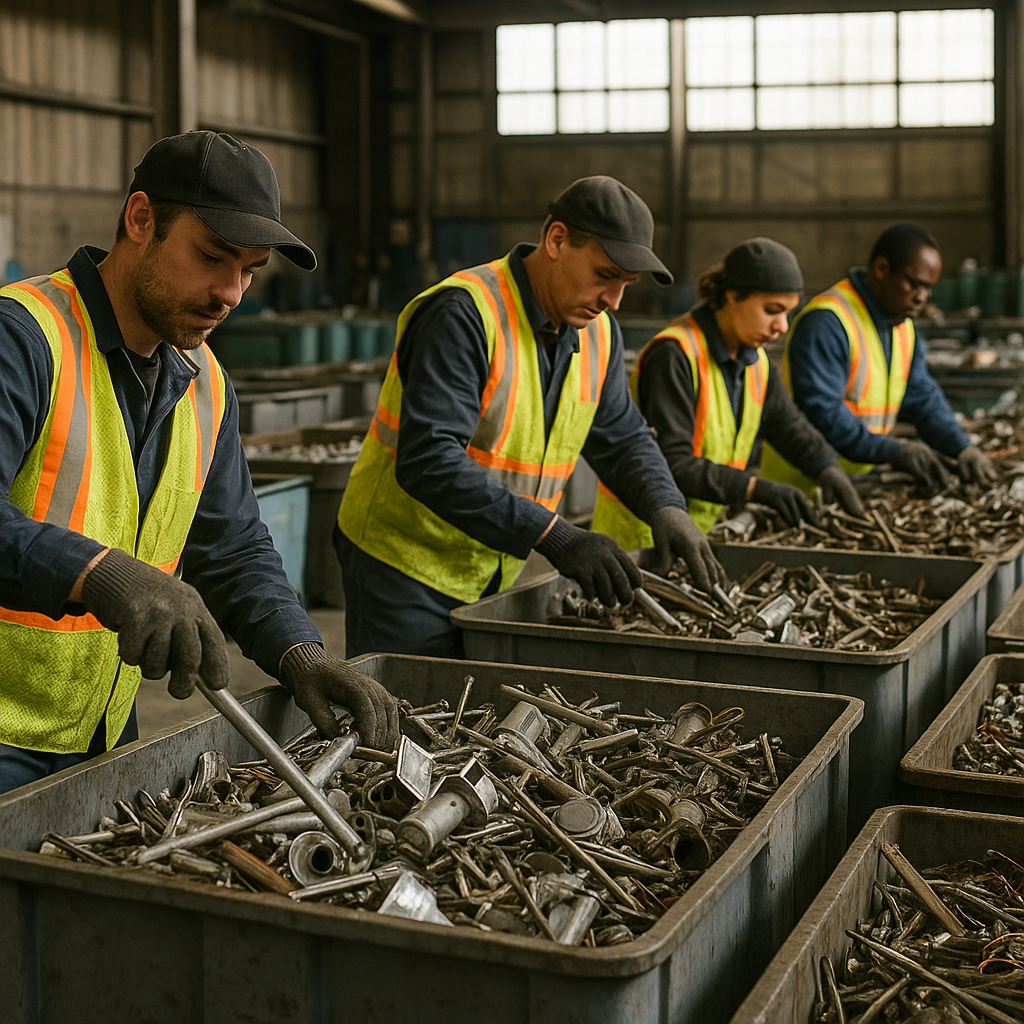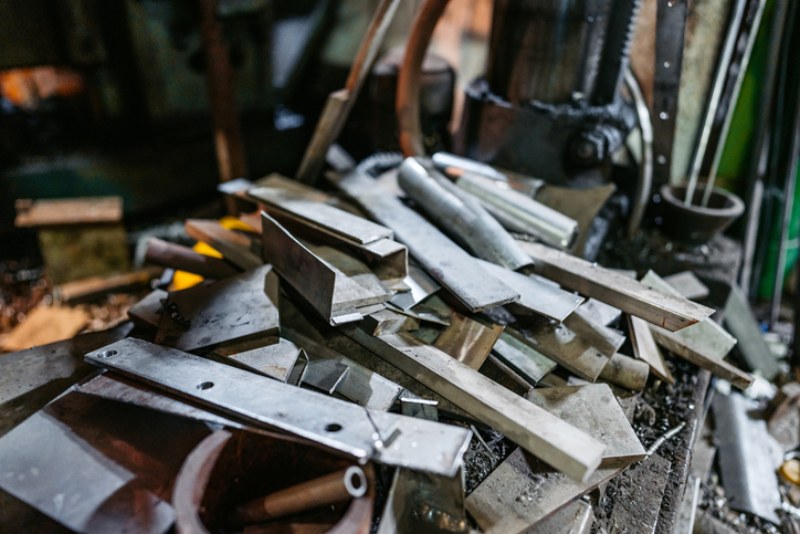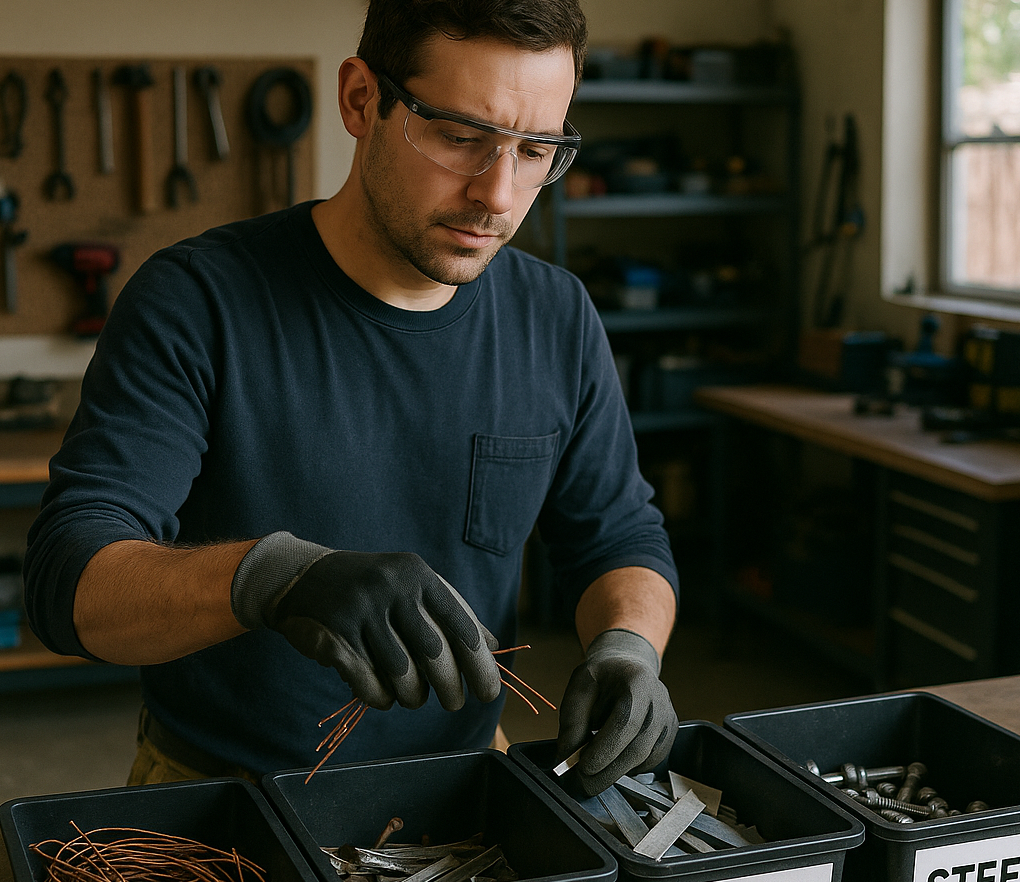5901 Botham Jean Blvd, Dallas, TX 75215
Exploring the Key Benefits of Sorting Scrap Metal?
July 13, 2025Did you know that properly sorting scrap metal can increase recycling returns by 20-40% compared to mixed scrap? This substantial financial advantage is just the beginning of what effective metal sorting can offer. When materials are correctly identified and separated, their value and recyclability dramatically improve.
Sorting scrap metal delivers significant economic benefits for businesses and recycling operations. It creates sustainable jobs in the recycling sector, reduces manufacturing costs through efficient resource recovery, and generates new revenue streams. The practice also enables scrap yards to process materials more efficiently, minimizing contamination risks.
Beyond the financial gains, sorted scrap metal provides crucial environmental benefits. It conserves natural resources by reducing the need for mining virgin materials. The process significantly decreases energy consumption—recycling aluminum, for instance, uses 95% less energy than producing it from raw ore. Additionally, proper sorting reduces greenhouse gas emissions and decreases waste ending up in landfills, contributing to a healthier ecosystem and more sustainable future.
How Does Sorting Scrap Metal Boost Economic Value?

Proper sorting of scrap metal creates substantial economic benefits throughout the recycling chain. When metals are separated by type and grade, their market value increases significantly. The process of dividing ferrous metals (which contain iron) from non-ferrous metals (like copper, aluminum, and brass) can boost returns by 30-50% compared to mixed metal loads.
Scrap yards pay premium prices for pre-sorted materials because sorting reduces their operational costs. When metals arrive already separated, recycling facilities spend less time and resources on processing. This efficiency translates directly to higher payouts for suppliers of well-sorted scrap.
The purity factor is also crucial in determining value. Contaminated or mixed metals require extra refining steps, reducing their worth. Clean, properly identified materials command top dollar because they can move directly to melting and manufacturing processes.
Value of Ferrous and Non-Ferrous Metals
The economic impact of sorting is clear when comparing ferrous and non-ferrous metals. Ferrous metals like steel and iron, while recyclable and useful, typically fetch lower prices due to their abundance. A simple magnet test identifies these materials quickly—if it sticks, it’s ferrous.
Non-ferrous metals command significantly higher prices in the market. Copper wiring, for instance, can be worth up to ten times more per pound than steel. Brass fixtures, aluminum components, and stainless steel pieces also increase substantially in value when separated from regular steel.
Recycling centers use specialized equipment, including magnets, sensors, and sometimes spectrometers, to sort metals accurately. Many facilities now employ laser-induced breakdown spectroscopy (LIBS) analyzers that identify specific metal grades within seconds, enhancing sorting precision and value.
| Metal Type | Mixed/Unsorted Price | Properly Sorted Price | Potential Increase |
|---|---|---|---|
| Copper | -30% to -50% of optimal | 100% of market value | Up to 50% more |
| Aluminum | -20% to -40% of optimal | 100% of market value | Up to 40% more |
| Brass | -15% to -30% of optimal | 100% of market value | Up to 30% more |
| Stainless Steel | Often missed in mixed scrap | Properly valued | Up to 300% more |
Grade Classification Increases Profits
Beyond the basic ferrous/non-ferrous division, further sorting by grade dramatically impacts economic returns. High-grade copper wire stripped of insulation might sell for three times the price of lower-grade copper with attachments. Similarly, clean aluminum without paint or other contaminants commands premium prices over mixed aluminum scrap.
This grade-based approach creates a tiered pricing system that rewards careful sorting. Businesses that invest time in proper metal separation often see rapid returns on this investment through higher payouts. Some recycling operations report that thorough sorting can transform marginally profitable recycling programs into significant revenue streams.
For industrial suppliers, implementing systematic sorting protocols throughout their operations yields consistent financial benefits. Manufacturing facilities that separate different alloys during production can recover substantial value from their waste streams, turning what was once a disposal cost into a revenue opportunity.
What Environmental Advantages Come from Sorting Scrap Metal?

Sorting scrap metal offers significant environmental benefits that extend beyond simply diverting materials from landfills. When metals are properly sorted by type and grade, recycling facilities can process them more efficiently, enhancing their environmental impact.
A major advantage is the substantial reduction in energy consumption. Recycling aluminum can save up to 95% of the energy required to produce it from bauxite ore. This translates to tangible savings—the energy conserved by recycling a single aluminum can could power a television for three hours. Similarly, recycling steel uses 75% less energy than producing it from virgin materials, with each ton of recycled steel saving about 1,400 pounds of coal.
Proper metal sorting also significantly reduces the need for environmentally destructive mining operations. Metal extraction typically involves land clearing, habitat destruction, and soil erosion. Recycling one ton of steel conserves 2,500 pounds of iron ore, 1,400 pounds of coal, and 120 pounds of limestone. These resources remain untapped, preserving natural landscapes and protecting biodiversity in mining regions.
Greenhouse gas emissions are markedly reduced through scrap metal recycling. The EPA reports that metal recycling reduces carbon dioxide emissions by approximately 29 million tons annually—equivalent to removing 6.3 million cars from the road for a year. This climate benefit results from reduced energy consumption in processing and the elimination of emissions associated with mining operations.
Water conservation is another critical environmental advantage. Metal production from raw ore is extremely water-intensive, while recycling processes require significantly less. For example, recycling copper can reduce water usage by up to 90% compared to primary production. This conservation is particularly valuable in drought-prone regions where water scarcity affects both communities and ecosystems.
Finally, metal sorting prevents toxic substances from entering the environment. When mixed with general waste, metals can leach harmful chemicals into soil and groundwater. Proper sorting ensures these materials are handled safely, preventing contamination of water supplies and surrounding ecosystems.
The comprehensive environmental benefits of sorting scrap metal make it one of the most impactful recycling activities for businesses and communities. Through proper sorting practices, a simple action creates a cascade of positive environmental outcomes across multiple ecosystems.
What are the Best Practices for Sorting Scrap Metal?

Sorting scrap metal efficiently can enhance its recycling value and promote environmental sustainability. Properly sorted scrap can increase returns by 20-40%. Systematic sorting processes ensure metals stay uncontaminated and retain their recycling potential.
Essential Tools for Effective Sorting
Using the right equipment ensures safer and more efficient sorting. Start with these basic tools:
- Strong magnet (preferably neodymium) for differentiating ferrous from non-ferrous metals
- Cut-resistant gloves to protect against sharp edges
- Safety glasses to shield eyes from metal fragments
- Clearly labeled sorting containers for different metal types
- Wire strippers for removing insulation from copper wiring
- Basic hand tools for dismantling complex items
Setting up a dedicated sorting area with good lighting and ventilation enhances safety and efficiency. Organize your sorting bins logically to maintain a smooth workflow.
Step-by-Step Sorting Process
Follow these steps to sort scrap metal effectively:
1. Perform the Magnet Test
The magnet test is crucial for initial sorting. Bring a strong magnet near each metal piece. If it sticks, place it in the ferrous (iron-containing) container, such as for steel and cast iron. If not, it is non-ferrous and potentially more valuable.
2. Identify Non-Ferrous Metals
For non-magnetic metals, use visual cues and weight to identify them:
- Copper: Reddish-brown color, moderately heavy
- Aluminum: Silvery-white, very lightweight
- Brass: Yellow or gold-like appearance, heavier than aluminum
- Bronze: Reddish-gold color
- Stainless Steel: Silver with a distinctive dull sheen (some grades are slightly magnetic)
If you’re unsure, file a small section to reveal the metal’s true color beneath any coating or corrosion.
3. Remove Contaminants
Non-metal components reduce scrap value significantly. Clean your metals by:
- Stripping insulation from copper and aluminum wires
- Removing plastic casings from electronic components
- Detaching wooden handles from tools
- Cleaning off oil, grease, and dirt
- Removing batteries and hazardous materials
Clean, contaminant-free metal can increase value by 30-50%, particularly for high-value metals like copper.
4. Dismantle Complex Items
Disassembling complex items into component metals can significantly boost their value. For example:
- Old appliances contain steel outer shells, copper motor windings, and aluminum components
- Electronics include aluminum cases, copper wiring, and circuit boards
- Vehicles have steel frames, aluminum engine parts, and copper wiring
When dismantled properly, these components sorted separately can yield 30-100% more value than scrapping the whole item.
Organization Systems for Maximum Efficiency
Implement a systematic organization approach:
- Use dedicated, clearly labeled containers for each metal type
- Consider further separating high-value metals by grade (e.g., #1 copper vs. #2 copper)
- Keep a “mystery metals” container for items you can’t immediately identify
- Store containers logically based on your workflow
This level of organization can increase returns by an additional 15-20% compared to basic sorting.
Safety Precautions
Safety is crucial when handling scrap metal:
- Always wear cut-resistant gloves and safety glasses
- Use proper lifting techniques for heavy items
- Ensure your tetanus vaccination is current
- Be cautious with potentially hazardous materials
- Work in a well-ventilated area
- Keep a first aid kit nearby
Cuts and puncture wounds are common in recycling operations. Proper protective gear greatly reduces these risks.
Common Sorting Mistakes to Avoid
Avoid these common errors:
- Mixing different types of non-ferrous metals
- Failing to remove contaminants like plastic or wood
- Not fully dismantling complex items
- Overlooking small but valuable components
- Ignoring safety precautions
By avoiding these mistakes, you’ll maximize both safety and value in your scrap metal recycling efforts.
| Metal Type | Characteristics |
| Aluminum | Lightweight, resistant to corrosion, good conductor of electricity, often used in aircraft and automobile parts |
| Steel (Carbon, Alloy, Stainless) | Strong, fracture-resistant, alloyed with elements like carbon and chromium to enhance properties |
| Copper | Soft, malleable, excellent electrical and thermal conductor, extensively used for wiring and electronics |
| Iron (Pig, Cast, Wrought) | Strong, dense, with ductile and corrosion-resistant wrought iron, used in construction and manufacturing |
| Titanium | Lightweight, strong, high thermal stability, corrosion-resistant, used in aerospace and medical implants |
| Brass | Alloy of copper and zinc, stronger than copper, used in locks and gears |
| Lead | Heavy, soft, malleable, used for lining tanks, pipes, and cables |
Implementing these best practices maximizes the value of your scrap metal and supports efficient recycling processes. Proper sorting can reduce processing energy by up to 20% and ensure valuable materials avoid landfills.
How Can Individuals and Businesses Maximize Returns from Scrap Metal Sorting?

The difference between average and exceptional returns in scrap metal recycling often comes down to strategic planning and informed decision-making. Whether you’re an individual with occasional scrap or a business generating regular metal waste, implementing smart practices can significantly boost your profits.
Market Price Monitoring and Strategic Timing
Metal prices fluctuate based on global supply and demand factors. Staying informed about current market rates helps identify the optimal time to sell. Several online resources provide up-to-date pricing information, including industry websites like Recycling Today and specialized apps that track local scrap metal prices.
Strategically timing your sales can increase returns by 10-20%. Consider holding non-ferrous metals like copper and aluminum during price dips if storage space permits. Market cycles tend to be predictable for certain materials, with construction season often bringing higher prices for industrial metals.
Set personal price thresholds for different metals based on historical data. This approach creates a disciplined selling strategy rather than making impulsive decisions during temporary market fluctuations.
Proper Sorting and Preparation
The effort invested in sorting and cleaning scrap metal directly impacts its value. Start by separating ferrous from non-ferrous metals using a simple magnet test. Further sort non-ferrous metals by type – copper, aluminum, brass, and others – as each commands different prices.
Remove all non-metal attachments such as plastic, rubber, or wood. For copper wire, stripping the insulation can increase its value by 30-50%. Clean grease, paint, and other contaminants from metal surfaces to ensure they qualify for higher-grade classification.
For businesses, training staff on proper identification and sorting protocols creates efficiency. Consistent labeling systems and dedicated sorting stations minimize cross-contamination and streamline the recycling process.
Building Valuable Industry Relationships
Developing strong relationships with recycling facilities offers multiple advantages. Regular customers often receive preferential treatment, faster service, and occasionally better rates. Choose recyclers with transparent pricing policies and a reputation for fair business practices.
Visit multiple facilities before committing to one partner. Compare not just prices but also their weighing practices, grading standards, and additional services like pickup for larger quantities. The lowest-hassle facility might be worth slightly lower per-pound rates if it saves significant time and transportation costs.
Maintain open communication with your recycling partners. Many will provide advice on improving your sorting methods or alert you to upcoming price changes. These relationships become particularly valuable during market downturns when buyers might be more selective.
| Approach | Benefit | Details |
|---|---|---|
| Proper Metal Sorting | Increased Returns | Sorting can boost returns by 30-50% due to reduced operational costs and premium prices for clean, separated metals. |
| Grade Classification | Higher Profits | Grade-based sorting increases value through premium pricing for high-grade metals like stripped copper wire. |
| Market Price Monitoring | Optimized Timing | Monitoring market rates and timing sales strategically can increase returns by 10-20%. |
| Industry Relationships | Better Rates | Strong relationships with recycling facilities can result in preferential treatment and occasionally better rates. |
| Technology Investments | Enhanced Efficiency | Using technology like magnetic and eddy current separators improves sorting efficiency and accuracy, offering substantial returns over time. |
Implementing Comprehensive Scrap Management Programs
Businesses generating significant metal waste should implement formal scrap management programs. Start by conducting a waste audit to identify all potential recyclable materials in your operations. Track the volume and types of scrap generated to establish benchmarks for improvement.
Consider dedicated collection systems for different metal types at the point of generation. Employee education is crucial – workers who understand the value of proper sorting are more likely to participate consistently. Regular training sessions keep sorting protocols fresh in everyone’s minds.
For manufacturing operations, analyze your production processes to minimize metal waste generation. Even small reductions in scrap rates can significantly impact your bottom line. The environmental benefits of such programs also contribute to sustainability goals and potential certification advantages.
Technology Investments for Business Efficiency
For businesses with large scrap volume, technology investments can dramatically improve sorting efficiency. Magnetic separators automatically remove ferrous metals from mixed waste streams. Eddy current separators can further sort non-ferrous metals based on their conductivity.
Advanced operations might consider spectroscopic analyzers that precisely identify metal compositions. While expensive, these tools quickly pay for themselves through increased accuracy and labor savings for operations handling complex alloys or high-value metals.
Even small businesses can benefit from basic technology. Digital scales for accurate weighing, inventory management software for tracking materials, and mobile apps for price monitoring require minimal investment while offering substantial returns.
Education and Industry Knowledge
Continuous learning about metal identification and recycling processes gives you a competitive edge. Industry publications, online forums, and recycling associations offer valuable information about emerging trends and best practices. The ability to accurately identify different grades of metal can prevent costly mistakes.
Stay informed about regulatory changes affecting scrap metal recycling. Environmental regulations and documentation requirements evolve regularly, and compliance is essential for smooth operations. Knowledge of specialized markets for certain materials can also open new revenue opportunities.
Networking with others in the industry provides access to shared knowledge and experiences. Attending industry events or joining relevant business associations creates opportunities to learn from both successes and mistakes of others in the field.
Conclusion: Embracing the Benefits of Scrap Metal Sorting
Sorting scrap metal is more than a waste management practice; it is a significant economic driver that generates billions in revenue and supports hundreds of thousands of jobs across collection, processing, and manufacturing sectors. By implementing proper sorting techniques, individuals and businesses can maximize their recycling returns while contributing to a vibrant economic activity that benefits local communities.
The environmental advantages complement these economic benefits. Proper sorting diverts metals from landfills, conserving valuable natural resources, reducing energy consumption, and lowering greenhouse gas emissions. Recycling one ton of aluminum can prevent up to nine tons of carbon emissions, and recycled steel production significantly reduces air and water pollution.
For assistance with your recycling needs and to learn more about maximizing the value of your scrap metal through proper sorting techniques, contact Okon Recycling at 214-717-4083. Our team of experts can help you implement efficient sorting practices that benefit both your bottom line and our shared environment.
